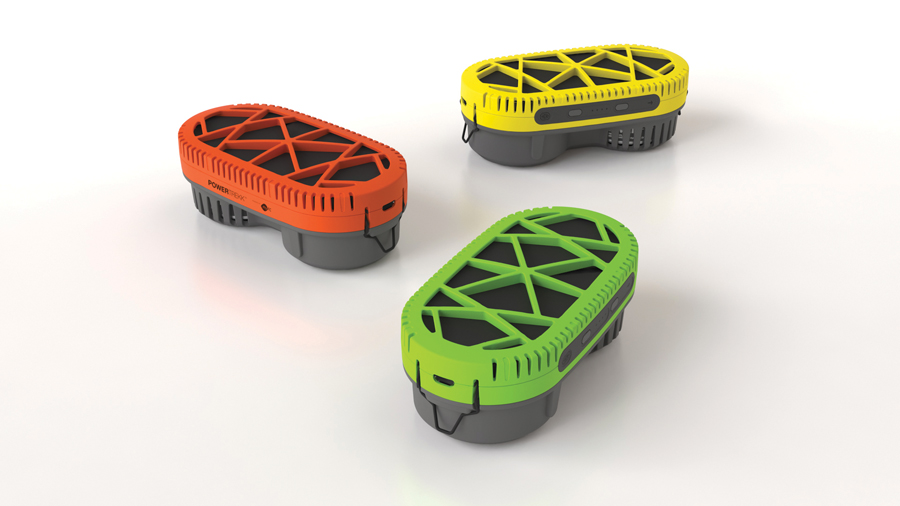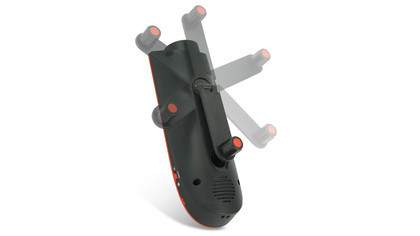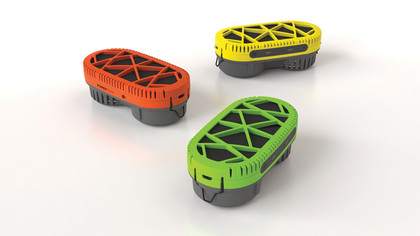How do you charge your phone when you're miles from a power socket?
There are all sorts of ways to provide renewable power to devices so why aren't we using them?

The arrival of the iPhone brought about a huge shift in mobile phones, but not everything changed. Despite seeming like a totally different device from what had come before, the iPhone has always been stuck with one legacy bit of technology - a battery that needs regular charging.
Rechargeable batteries are still the best solution for powering devices such as phones or iPads, but their need to be tethered to the mains for juicing up isn't just an inconvenience, it's also often not an option if you're travelling or camping.
External battery packs exist for providing you with a power boost, but these use the same kind of battery as a mobile phone - and these batteries aren't good for the environment. They're toxic and can pollute areas when they're disposed of, so in an ideal world, we'd avoid using them. But how else can you get power for your gadgets when you're stuck, away from a power point?
Solar chargers

Solar energy has always been the dream option for providing renewable alternative energy, but we're still waiting for it to become a mainstream option. The problem, particularly for small devices, is that it's hard to get enough energy from solar cells reliably, especially in countries like the UK, where sunlight is sporadic at the best of times.
The problem is one of scale. It's possible to produce a decent amount of power from a large array of solar panels arranged on a building's roof, but carrying a dozen square metres of photovoltaic panels isn't really practical if you're out hiking.
There are ways around this, though. Flexible solar panels have been touted as a possibility, letting you roll a larger panel into smaller area for storage, so when you stop, you could spread it out. The only problem is that you need solar panels to be receiving sun for long periods of time if you want them to generate an appreciable amount of power.
For this reason, many solar chargers have a built-in battery, which lets them build up power slowly and then discharge it to your phone at a steadier rate (which is better for the phone's battery), but this means they're only really useful for emergency situations, rather than as a way to regularly charge your phone.
Sign up for breaking news, reviews, opinion, top tech deals, and more.
There has been talk of having solar panels built into phones, and Apple itself is rumoured to have considered this, but the small amount of power this would generate means it would only be a way to extend the battery life on standby, rather than free you from having to charge.
Crank power

There's a similar situation when it comes to charging your phone using brute force. Certain devices enable you crank a dynamo to generate stored power, but it's probably fair to call this too inefficient to be practical on anything other than an emergency basis. In fact, we tried hand-cranking one manual iPhone charger for 10 minutes and the iPhone's battery actually went down in that time.
However, the same device has a built-in 800mAh rechargeable battery, enough to provide half a charge of an iPhone 4S, so if you cranked away to charge that battery, and then plugged your iPhone in to provide a power boost, you'd certainly have enough for a phone call. Again, that's handy for an emergency, but not a solution for regular charging.
A slightly more practical way to get power from your own efforts is with a dynamo attached to a bike, so you can build up power on your ride. Again, these often have a built-in battery that charges while you're cycling, so even though it might be an environmentally friendly way to generate power, it's still not much of a green solution overall. Overall, it's fair to say that so-called cranking solutions aren't likely to catch on for your iOS device.
Hydrogen fuel cells

Hydrogen fuel cells are a source of energy that's finally starting to become available to all. These store energy much like a battery pack, but can do so without using any toxic materials.
Currently, they take the form of external power packs for the likes of the iPhone or iPad, providing some extra charge when you connect them. How much charge they can provide depends on the capacity of the cells, but the actual fuel cells themselves can be replaceable, so you could potentially take several extras with you that can then be fitted into a charging unit, to which you'd connect your iPhone or iPad.
Horizon is one company about to launch such a system designed for devices like iPhones. It uses Hydrostiks - a series of battery-like hydrogen fuel cells - which slot into a charging unit called the MiniPak. This is a light, portable unit, designed to be carried around in a backpack. The cost of additional Hydrostiks is quite low, so the idea is that you'd take several with you, to get through any length of journey or trip.
Horizon intentionally made its fuel cells look like batteries to try to make them as familiar as possible to people, so it would seem like a natural switch. In fact, thinking of them as rechargeable batteries is probably the most accurate way to look at it.

Each Hydrostik contains a finite amount of energy, and while the Horizon system uses normal water to produce its hydrogen, you can't simply fill the Hydrostiks from the sink to get more power in them. Horizon sells a refilling station called the Hydrofill that you can buy for your home (or you can send your Hydrostiks back to Horizon and they'll refill them for a small fee).
The Hydrofill itself actually does just need to be topped up with water, and it then bonds the hydrogen with metal hydrides in the Hydrostiks to fill them with power again. This process actually requires power to perform, so it's important to note that this won't produce energy from nowhere (which is of course impossible) - it's simply a different, more environmentally friendly way to store it, because the Hydrostiks are recyclable and aren't toxic like most batteries.
That said, Horizon is hoping to be able to offer the Hydrofill with a solar panel to attach to your building, which would provide enough power for the hydrogen bonding. In this way, the Hydrostiks would effectively be able to offer free power, simply from water.
Each Hydrostik offers about 15WH of battery life, which is enough to offer several charges of an iPhone 4S, but the MiniPak that they use to provide the charge is too low a voltage to charge an iPad, though Horizon says it's working on more powerful solutions.
The combination of a Hydrostik and MiniPak only weighs about 150g, so is comparable to most standard battery packs that offer a similar amount of charge when it comes to carrying them around - although the fact that you can carry a second Hydrostik offers a weight advantage.
More hydrogen ideas
Horizon isn't the only company about to release a hydrogen fuel cell system, though. PowerTrekk is a portable power solution that actually offers more convenience for hikers and the like than the Hydrostiks, but isn't as renewable.
The PowerTrekk uses fuel cells called PowerPukks, and these use a chemical hydride process instead of the Hydrostik's metal hydride. The upshot of this is that you don't need a refilling station to add any charge to them - you just pop them in the PowerTrekk and add about a spoon's worth of water. But once they're used, that's it - you'll have to dispose of them.
So if hydrogen fuel cells are so convenient, why haven't we seen them before? In the case of Horizon's Hydrostiks, the simple answer is that the technology has only been around for a few years, and Horizon is the first company to get the cost of production down to a level where it could be commercially successful.
There's also an issue with perception of new technologies. Horizon's decision to make the Hydrostik look like a battery is intended to make it more familiar to people, but hydrogen fuel solutions also have a reputation for being potentially explosive. However, that was only a risk with fuel cell designs that compressed the hydrogen to store it. These fuel cells that bond the hydrogen to a chemical or metal don't suffer from the same danger.
The same can't be said of traditional rechargeable batteries, which can overheat and combust, particularly if used with inferior-quality chargers.
Battery and power technology is constantly evolving, and it's one of the areas where there are real, immediate gains to be made. But having better batteries in future devices doesn't help you keep your iPhone 4S topped up now, and it looks like hydrogen fuel cells will be the most reliable way to provide portable power without using a traditional battery pack in the near future.
It's exciting to see the advent of new technologies reaching the shops, and it's nice to feel that the environment is just a little better off as a result.